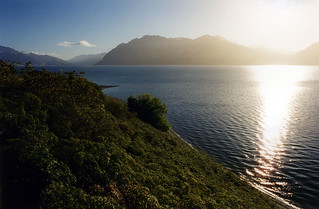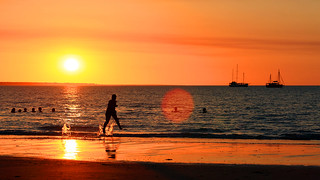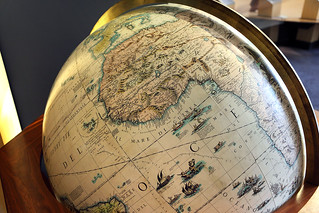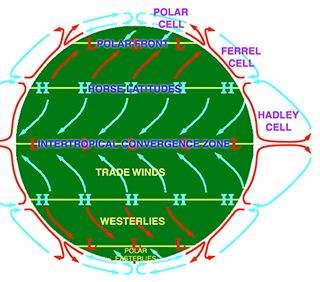

|
Archive
Blog
Cast
Forum
RSS
Books!
Poll Results
About
Search
Fan Art
Podcast
More Stuff
Random
Support on Patreon |
|
New comics Mon-Fri; reruns Sat-Sun
|
1 {photo of a yacht leaning in the wind}
1 Caption: Wind
|
First (1) | Previous (3285) | Next (3287) || Latest Rerun (2581) |
Latest New (5175) First 5 | Previous 5 | Next 5 | Latest 5 Annotations theme: First | Previous | Next | Latest || First 5 | Previous 5 | Next 5 | Latest 5 This strip's permanent URL: http://www.irregularwebcomic.net/3286.html
Annotations off: turn on
Annotations on: turn off
|
 Sun shining on land and water. |
What the sun does is to heat up regions of the Earth on which it shines. If it weren't for the sun, Earth would be a frozen ball, covered in a thick layer of ice. The sun provides enough heat to keep most of our water molten. The temperature of most of the water in the world is still very cold - far too cold to go comfortably swimming in. The sun only warms water appreciably in tropical and subtropical regions, and then only in a shallow surface layer. Fortunately for swimmers, it's the shallow surface layer we like to swim in, whether that be in the ocean or in lakes or rivers.
So the surface temperature of the ocean varies across the globe. The land also absorbs the heat of the sun, and it does it better, in the sense that the land gets hotter faster than the ocean does. This is because of the property known as the specific heat of substances.
Specific heat determines how much heat energy is required to bring about a certain rise in temperature. You might think that this should always be the same (add X amount of thermal energy, get Y degrees of temperature rise), but in fact it depends on the substance being heated, and in a non-intuitive way. Things like metal and rocks tend to heat up fairly quickly. Put a rock into a hot oven, and it will heat up to match the oven temperature in a certain amount of time. Put the same mass of water (in a dish), or even the same volume of water (which is smaller) into the oven, and it will take a longer time to heat up. Water actually requires more energy to heat up for every degree of temperature than the same mass (or the same volume) of metal or stone. We say that water has a higher specific heat than the other substances.[1]
 See breeze time. |
Another effect this difference has is on winds. Hot air tends to rise - this is the principle behind the hot air balloon. During the day, land tends to heat up, causing the air to be less dense. If there is local variation in the temperature, the air will rise in the warmer regions and fall in the cooler regions to take its place. One form of local variation can be provided by a coastline, as the air over the sea will be cooler during the day. The result is that on warm afternoons the air rises over land, and sinks over the sea. To replace the air over the land, a cool breeze begins to blow inland from the ocean. We call this a sea breeze, and you will experience it if you ever spend a fine day in a warm, sunny coastal location. Higher in the atmosphere, away from our notice down on ground level, the air completes a circuit by blowing back out to sea, where it sinks and starts the cycle again. These sorts of vertical circuits driven by differences in temperature are called convection cells.
At night, the water retains its temperature better than the land. Its high specific heat means it has to lose more thermal energy than the land for a similar temperature drop, so it takes longer to cool down. When the land surface temperature drops below that of the sea, the air circulation starts to reverse, rising over the now warmer sea and sinking over the land. This causes a breeze to blow out from the land towards the sea, called a land breeze.
 The Earth spins on its axis, complicating wind movements. |
Generally speaking, the sun tends to cause tropical regions near the equator to warm up more than areas closer to the poles. This sets up a more or less steady circulation of air, rising near the equator and sinking back down at higher latitudes. Because of issues of stability of large scale motions of the atmosphere, this does not form a single large convection cell of air rising at the equator, blowing towards a pole, sinking near the pole, and blowing all the way across the surface back to the equator. The circulation actually breaks up into smaller cells of air movements.
Air rising near the equator tends to start sinking again by the time it reaches about latitude 30° north or south. These cells (one either side of the equator) are called the Hadley cells, after the English meteorologist George Hadley. There are similar cells in each hemisphere with air rising at about 60° and sinking close to the poles, called the polar cells. In between these, the air sinking around latitude 30° and rising around 60° drives surface winds which blow from the lower latitude to the higher one, in spite of the fact that temperatures around 30° latitude tend to be warmer than at 60°. Air movements in these middle latitude regions are effectively dominated by the combined stronger air movements of the equatorial and polar regions. These cells are called the Ferrel cells, for the American meteorologist William Ferrel.
The next complication is caused by the fact that the Earth rotates. In the northern hemisphere, as you travel north you are also moving closer to the axis of Earth's rotation. When you are on the equator, the spinning of the Earth once per day means you are actually moving east at a speed of roughly 1700 km/h, measured relative to the centre of the planet. If you stood still at the North Pole, you'd be spinning around your vertical axis once per day, but not moving.[2] In between, you are moving east at intermediate speeds. Now, if you are travelling north, then you have more eastward speed than you need as you get further north. The result is that you tend to drift to the east. Conversely, if travelling south, you have less eastward speed than you need to keep up with the Earth's rotation closer to the equator, and you tend to drift to the west. In the southern hemisphere, the directions are reversed, you tend to drift west as you travel north, and east as you travel south.
 Figure 1: Wind circulation on Earth. Creative Commons Attribution-Share Alike image by Wikimedia user DWindrim from Wikimedia Commons. |
This general pattern of winds was well known hundreds of years ago to people for whom knowledge of the wind was vitally important: sailors. As the European powers of the 15th century began exploring the wider world in large sailing ships for the first time, they quickly discovered that some directions were easier to sail in than others. To travel west from Europe, one had to first head south towards Africa, where the winds would tend to blow to the west. At the latitude of Europe, winds tended to blow from the west, towards the east. This could be used to return to Europe from the Americas, but not travel westward. For similar reasons, travel to South Africa could not be done straight down the coast of Africa as you might expect. The winds blew in exactly the wrong direction. To go from Europe to South Africa, you had to sail west towards Brazil, then south down the coast of South America until you reach the latitude of southern Africa, before finally turning east and heading back to Africa.
The winds of the northern Hadley cell blow south-west, and the southern Hadley cell blows north-west. This makes sailing to the west easy in the tropics, but sailing to the east difficult. Fortunately, the Ferrel cells blow in the opposite directions, to the northeast in the northern hemisphere, and to the south-east in the southern hemisphere. The easterly winds of the Hadley cells (winds are named for the direction they blow from, so an easterly wind blows from the east, to the west) became known as the trade winds, as they enabled the burgeoning new trade routes of the growing European empires. The westerly winds of the Ferrel cells became known simply as the westerlies.
These wind patterns made travel to certain parts of the world easier or more difficult, thus shaping the expansions of the European powers. They provide powerful examples of how the quirks of geography can exert a major influence over human history and politics. One particular effect of the wind patterns was that travel between Europe and the new colonies in the Americas necessarily involved a close pass by Africa on the way west. This enabled what became known as the triangular trade. Ships leaving Europe would carry relatively cheap trinkets and weapons as cargo. These would be traded to African rulers and European merchants in exchange for slaves. The slaves would then be carried west to the Americas on the trade winds, and exchanged there as labour to work on plantations producing goods desired in Europe: sugar, cotton, tobacco, and spices. These would then be carried to Europe on the westerlies and sold for huge profits.
The Earth's large scale wind patterns are affected on smaller scales by the planet's geography, making what we consider to be the weather. But I think that's all I have time for this week (I have been a bit busier than usual), so I will continue another time.
[2] We are all of course also moving around the sun in the Earth's yearly orbit, and moving around the centre of our Galaxy as the sun orbits that, but these are not important for today's discussion.
|
LEGO® is a registered trademark of the LEGO Group of companies,
which does not sponsor, authorise, or endorse this site. This material is presented in accordance with the LEGO® Fair Play Guidelines. |